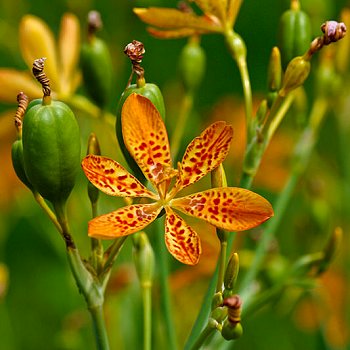
|
|
Belamcanda
chinensis
|
Belamcanda chinensis - Leopard lily
Belamcanda chinensis (Iris domestica, Blackberry lily, Leopard flower, Leopard
lily, Belamcanda punctata Moench, Gemmingia chinensis (L.) Kuntze, Iris chinensis Curtis, Ixia chinensis L., Morea chinensis, Pardanthus chinensis (L.) Ker Gawl.) is an ornamental plant in the Iridaceae family. In 2005, based on molecular DNA sequence evidence, Belamcanda chinensis, the sole species in the genus Belamcanda, was transferred to the genus Iris and renamed Iris
domestica.
Belamcanda chinensis, is a short-lived perennial, of Chinese origin,
that reseeds easily. The plant grows 60-90 cm tall in full sun and is often found blanketing hill
sides, the flowers can range from red to yellow to orange or mixed and bloom in summer to early autumn
(fall). The leaves grow in a fan, like those of a gladiolus. The flowers are typically orange spotted with
red, although yellow-flowered varieties are in cultivation. The seed pods open in the
fall, showing clusters of black seeds whose fancied resemblance to a blackberry gives the plant its common
name, "blackberry lily." Seeds are not edible. The plant is also
known as leopard lily because of the dark markings on its flowers. The plant is propagated by seeds or
division.
A durable perennial that deserves more use in
perennial gardens and flower
beds. Plant cluster of three or more plants to enjoy the April-through-October shoots of orange blossoms dotted with dark
spots, plus periodic blooms during the remaining warmer days of fall. Plants can also be grown in containers for
porch, balcony and patio displays. Belamcanda chinensis
grows best in well-drained soil in the sun or partial shade, but will grow in clay or sand
soil.
The dried rhizome of Belamcanda chinensis has long been used in East Asia to treat throat troubles, asthma, swollen liver and spleen, gonorrhea, malaria, and arrow
poisoning. The leopard lily has a very long history of use in traditional Chinese
medicine. It is a bitter cooling herb that acts mainly on the lungs and the
liver, lowering fevers and reducing inflammation. It is effective against a number of
bacterial, fungal and viral organisms and has also been used as an antidote to
snakebites. The root contains several medically active constituents including flavonoids and
isoflavonoids. It also contains the glucosides belamcandin, tectoridin, shekanin and
iridin. It is analgesic, antibacterial, antifungal, anti-inflammatory,
depurative, expectorant, febrifuge, pectoral, purgative, stomachic and tonic. It is used in the treatment of acute
laryngitis, acute tonsillitis, oedema of the glottis and cough with profuse
sputum. The juice of the root is used in Nepal to treat liver complaints, where it has the added benefit of improving the
appetite. This juice is also used to abort a foetus during the first trimester of
pregnancy. The root should not be prescribed for pregnant women. The root is harvested in the summer and
autumn, and dried for later use. Currently, studies are underway to investigate its apparent potential against prostate cancer.
Source:
http://en.wikipedia.org/wiki/Iris_domestica
http://www.pfaf.org/user/Plant.aspx?LatinName=Belamcanda%20chinensis
